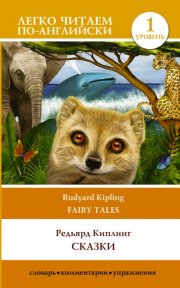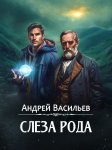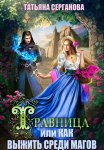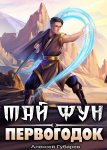Читать онлайн Сказки / Fairy Tales. Уровень 1 бесплатно

© Матвеев С.А., адаптация текста, комментарии, упражнения, словарь
© ООО «Издательство АСТ», 2021
Rudyard Kipling
Fairy Tales
How the Whale got his throat
In the sea, once upon a time, there was a Whale, and he ate fishes. He ate the starfish and the garfish, and the crab and the dab, and the plaice and the dace, and the skate and his mate, and the mackerel and the pickerel, and the eel. All the fishes he could find in all the sea he ate with his mouth – so! But at last there was only one small fish left[1] in all the sea, and that was a small Astute Fish[2], and it swam a little behind the Whale’s right ear. So the Whale could not catch it. Then the Whale stood up on his tail and said,
“I’m hungry.’
And the small Astute Fish said,
‘Noble and generous Cetacean, did you taste Man?’
‘No,’ said the Whale. ‘What is it like?[3]’
‘Nice,’ said the small Astute Fish. ‘Nice but nubbly.’
‘Then fetch me some,’ said the Whale, and swam away.
‘If you swim to latitude Fifty North, longitude Forty West[4],’ said the Astute Fish, ‘you will find a man. He is sitting on a raft, in the middle of the sea, he has only a pair of blue canvas breeches, a pair of suspenders, and a jack-knife[5]. He is a shipwrecked Mariner.’
So the Whale swam and swam to latitude Fifty North, longitude Forty West, as fast as he could swim. And the Whale found one single, solitary shipwrecked Mariner. The Mariner was on a raft, in the middle of the sea. He had a pair of blue canvas breeches, a pair of suspenders, and a jack-knife.
Then the Whale opened his mouth back and back and back till it nearly touched his tail. And then he swallowed the shipwrecked Mariner and his raft, and his blue canvas breeches, and the suspenders, and the jack-knife. After that the Whale smacked his lips, and turned round three times on his tail.
But when the Mariner found himself[6] inside the Whale’s dark stomach, he stumped and he jumped and he thumped and he bumped, and he pranced and he danced, and he banged and he clanged, and he hit and he bit, and he leaped and he crept, and he prowled and he howled, and he hopped and he dropped, and he cried and he sighed, and he crawled and he bawled, and he stepped and he danced. The Whale felt very unhappy.
So the Whale said to the Astute Fish,
‘This man is very nubbly, and besides I hiccup because of him. What to do?’
‘Tell him to come out,’ said the Astute Fish.
So the Whale cried to the shipwrecked Mariner, ‘Come out and behave yourself[7]. I hiccup because of you.’
‘No, no!’ said the Mariner. ‘Take me home first!’
And he began to dance again.
‘You must take him home,’ said the Astute Fish to the Whale. ‘There is no other way.’
So the Whale swam and swam and swam, with both flippers and his tail, as fast as he could. At last he saw the Mariner’s land, and he rushed to the beach, and opened his mouth wide and wide and wide, and said,
‘Walk out!’
And the Mariner walked out of his mouth. But the Mariner was very cunning: he took his jack-knife and cut up the raft into a little square grating, and he tied it with his suspenders, and he dragged that grating into the Whale’s! Then he sang the song:
- With this grating,
- I stop your eating.
After that the Mariner stepped out on the shingle, and went home to his mother. Then he married and lived happily enough.
But from that day on, with that grating – which was in the Whale’s throat – the Whale could eat nothing except very, very small fish. That is the reason why whales nowadays never eat men or boys or little girls.
The small Astute Fish went away and hid himself in the mud. It was afraid that the Whale was angry with it.
How the Camel got his hump
In the beginning of years, when the world was so new, and the animals began to work for Man, there was a Camel. He lived in the middle of a Howling Desert[8]because he did not want to work. Besides, he was a Howler[9] himself. So he ate sticks and thorns and tamarisks and milkweed and prickles. When anybody spoke to him he said ‘Humph!’ Just ‘Humph!’ and no more.
Presently the Horse came to him on Monday morning, with a saddle on his back and a bit in his mouth, and said,
‘Camel, O Camel, come out and trot like the rest of us.’
‘Humph!’ said the Camel; and the Horse went away and told the Man.
Presently the Dog came to him, with a stick in his mouth, and said,
‘Camel, O Camel, come and fetch and carry like the rest of us.’
‘Humph!’ said the Camel; and the Dog went away and told the Man.
Presently the Ox came to him, with the yoke on his neck and said,
‘Camel, O Camel, come and plough like the rest of us.’
‘Humph!’ said the Camel; and the Ox went away and told the Man.
At the end of the day the Man called the Horse and the Dog and the Ox together, and said,
‘You three, I’m very sorry for you; but that Camel in the Desert can’t work. So I want to leave him alone, and you must work double-time.’
That made the Horse and the Dog and the Ox very angry, and they discussed the situation with the Camel on the edge of the Desert. But the Camel chewed milkweed and laughed at them. Then he said ‘Humph!’ and went away again.
Presently the Djinn appeared. He was in charge of[10] all deserts. The Djinn rolled in a cloud of dust (Djinns always travel that way because it is magic), and he stopped to talk to the Three.
‘Djinn of All Deserts,’ said the Horse, ‘is it right for anyone to be idle’
‘Certainly not,’ said the Djinn.
‘Well,’ said the Horse, ‘there’s a Camel in the middle of your Howling Desert with a long neck and long legs, and he does not work at all. He doesn’t want to trot.’
‘Whew!’ said the Djinn and whistled, ‘that’s my Camel! What does he say about it?’
‘He says “Humph!”’ said the Dog; ‘and he doesn’t want to fetch and carry.’
‘Does he say anything else?’
‘Only “Humph!”; and he doesn’t want to plough,’ said the Ox.
‘Very good,’ said the Djinn. ‘I’ll humph him if you wait a minute.’
The Djinn rolled himself up in his dust-cloak, and flew away. He found the Camel most idle. The Camel looked at his own reflection in a pool of water.
‘My friend,’ said the Djinn, ‘they say you don’t work. Is it true?’
‘Humph!’ said the Camel.
The Djinn sat down, with his chin in his hand, and began to think. The Camel looked at his own reflection in the pool of water again.
‘I’ll give you three tasks on Monday morning,’ said the Djinn.
‘Humph!’ said the Camel.
‘Why do you say ‘Humph!’?’ asked the Djinn; ‘I want you to work.’
And the Camel said ‘Humph!’ again. But suddenly he saw his back and was afraid: his back puffed up into a great big humph.
‘Do you see that?’ said the Djinn. ‘That’s your own humph. You don’t work, and you have it! Now begin to work!’
‘How can I work,’ asked the Camel, ‘with this humph on my back?’
‘Today is Thursday. You will be able to work now for three days without any food’ said the Djinn, ‘because you missed three days – Monday, Tuesday and Wednesday. You can live on your humph. Come out of the Desert and go to the Three. Begin to work! And behave yourself!’
And the Camel went away to join the Three. And from that day to this the Camel always wears a humph. But he doesn’t know how to behave.
How the Rhinoceros got his skin
Once upon a time, on an uninhabited island on the shores of the Red Sea, there lived a Parsee. And the Parsee lived by the Red Sea with nothing but his hat, from which the rays of the sun were reflected, and his knife and a cooking-stove. And one day he took flour and water and currants and plums and sugar and things, and made himself a cake. The cake was two feet across and three feet thick. The Parsee put it on the stove, and he baked it. He baked it till it was all brown and smelt most sentimental.
But when he wanted to eat it there came down to the beach a Rhinoceros with a horn on his nose, two piggy eyes, and bad manners. In those days the Rhinoceros’s skin was quite tight. There were no wrinkles in it anywhere. He had no manners then, and he has no manners now, and he never will have any manners. He said, ‘How!’ and the Parsee left that cake and climbed to the top of a palm tree with his hat, from which the rays of the sun were reflected. The Rhinoceros upset the oil-stove with his nose. The cake rolled on the sand, and he spiked that cake on the horn of his nose, and he ate it. And he went away. Then the Parsee came down from his palm-tree.
Five weeks later, the Red Sea was very hot, and everybody took off all the clothes they had. The Parsee took off his hat; but the Rhinoceros took off his skin and carried it over his shoulder as he came down to the beach to bathe. In those days it buttoned underneath with three buttons and looked like a waterproof. He said nothing about the Parsee’s cake. The Rhinoceros waddled straight into the water and blew bubbles through his nose. His skin was on the beach.
Presently the Parsee came by and found the skin. He smiled, and the smile ran all round his face two times. Then he danced three times round the skin and rubbed his hands. Then he went to his camp and filled his hat with cake-crumbs[11]. You know, the Parsee never ate anything but cake, and never swept out his camp. He took that skin, and he shook that skin, and he scrubbed that skin, and he rubbed that skin just as full of old, dry, stale, tickly cake-crumbs and some burned currants. Then he climbed to the top of his palm-tree and waited.
The Rhinoceros came out of the water and put it on. He buttoned it up with the three buttons, and it tickled like cake-crumbs in bed. Then he wanted to scratch, but that made it worse[12]. Then he lay down on the sands and rolled and rolled and rolled, and every time he rolled the cake-crumbs tickled him worse and worse and worse.
Then he ran to the palm-tree and rubbed and rubbed and rubbed himself against it. He rubbed so much and so hard that he rubbed his skin into a great fold over his shoulders, and another fold underneath. He rubbed some more folds over his legs. But it didn’t work. The cake-crumbs were inside his skin and they tickled. So he went home, very angry indeed and horribly scratchy.
From that day to this every rhinoceros has great folds in his skin and a very bad temper, because he has many cake-crumbs inside.
How the Leopard got his spots
Once upon a time, the Leopard lived in a place called the High Veldt. There were sand and sandy-coloured rock and tufts of sandy-yellowish grass in that place. The Giraffe and the Zebra and the Eland and the Koodoo and the Hartebeest lived there. They were exclusively sandy-yellow-brownish all over; but the Leopard was the exclusivest sandiest-yellowish-brownest of them all. He was the greyish-yellowish catty-shaped beast in that place. This was very bad for the Giraffe and the Zebra and the rest of them, because he liked to lie down by a yellowish-greyish-brownish stone or clump of grass, and when the Giraffe or the Zebra or the Eland or the Koodoo or the Bush-Buck or the Bonte-Buck came by he jumped and caught them. He did so! And, also, there was an Ethiopian with bows and arrows (a exclusively greyish-brownish-yellowish man), who lived on the High Veldt with the Leopard. The two hunted together – the Ethiopian with his bows and arrows, and the Leopard exclusively with his teeth and claws – till the Giraffe and the Eland and the Koodoo and the Quagga and all the rest of them didn’t know which way to jump. They didn’t indeed!
After a long time, the animals learned to avoid anything that looked like a Leopard or an Ethiopian. And bit by bit[13] (the Giraffe began it, because his legs were the longest) they went away from the High Veldt. They scuttled for days and days and days till they came to a great forest, exclusively full of trees and bushes and stripy, speckly shadows, and there they hid.
After another long time, the Giraffe grew blotchy, and the Zebra grew stripy, and the Eland and the Koodoo grew darker, with little wavy grey lines on their backs like bark on a tree trunk. Though you could hear them and smell them, you could very seldom see them: only when you knew precisely where to look. They had a beautiful time in that forest, while the Leopard and the Ethiopian were puzzled. Where are their breakfasts and their dinners? At last the Leopard and the Ethiopian were so hungry that they ate rats and beetles and rock-rabbits. And they both had a terrible stomach-ache.
Then they met a Baboon, who is the wisest animal in all South Africa.
The Leopard asked the Baboon (and it was a very hot day),
‘Where are all the animals?’
And the Baboon winked. He knew.
The Ethiopian asked the Baboon,
‘Can you tell me the present habitat of the animals?’
And the Baboon winked. He knew.
Then the Baboon said,
‘The animals went into other place; and my advice to you, Leopard, is to go there as soon as you can.’
And the Ethiopian said,
‘That is all very fine, but I wish to know where they are.’
Then the Baboon said,
‘The animals changed their place, because it was high time for a change; and my advice to you, Ethiopian, is to change as soon as you can.’
That puzzled the Leopard and the Ethiopian. They went away and after many days they saw a great, high, tall forest full of tree trunks and shadows.
‘What is this,’ said the Leopard, ‘that is so exclusively dark, and yet so full of little pieces of light?’
‘I don’t know,’ said the Ethiopian, ‘but I can smell Giraffe, and I can hear Giraffe, but I can’t see Giraffe.’
‘That’s curious,’ said the Leopard. ‘I can smell Zebra, and I can hear Zebra, but I can’t see Zebra.’
‘Wait a bit,’ said the Ethiopian. ‘We saw them a long time ago. Perhaps we don’t remember anymore what they are like.’
‘Nonsense!’ said the Leopard. ‘I remember them perfectly on the High Veldt, especially their marrow-bones. Giraffe is about seventeen feet high, of a exclusively fulvous golden-yellow from head to heel; and Zebra is about four and a half feet high, of a exclusively grey-fawn colour from head to heel.’
‘Umm,’ said the Ethiopian, and looked into the speckly-spickly shadows of the forest. ‘Then they will soon appear in this dark place like ripe bananas.’
But they didn’t. The Leopard and the Ethiopian hunted all day; and though they could smell the animals and hear the animals, they never saw one of them.
‘Let us wait till dark,’ said the Leopard, ‘This daylight hunting is a perfect scandal.’
So they waited till dark, and then the Leopard heard something. It breathed sniffily in the starlight, and he jumped at the noise, and it smelt like Zebra, and it felt like Zebra, and when he knocked it down it fell like Zebra, but he couldn’t see it. So he said,
‘Be quiet, an animal without any form. I will sit on your head till morning, because there is something about you that I don’t understand.’
Presently he heard a grunt and a crash and a scramble, and the Ethiopian called out,
‘I have an animal that I can’t see. It smells like Giraffe, and it kicks like Giraffe, but it hasn’t any form.’
‘Don’t you trust it,’ said the Leopard. ‘Sit on its head till the morning – same as me. They haven’t any form – any of them.’
So they sat down on them hard till bright morning-time, and then Leopard said,
‘What have you, Brother?’
The Ethiopian scratched his head and said,
‘It is orange-tawny from head to heel, and it must be Giraffe; but it is covered all over with chestnut blotches. And what have you, Brother?’
And the Leopard scratched his head and said,
‘It is greyish-fawn, and it must be Zebra; but it is covered all over with black and purple stripes. Zebra, what’s wrong with you? When you were on the High Veldt, you looked different. And now you haven’t any form.’
‘Yes,’ said the Zebra, ‘but this isn’t the High Veldt. Can’t you see?’
‘I can now,’ said the Leopard. ‘But I couldn’t see yesterday. What happened?’
‘Come,’ said the Zebra, ‘and we will show you.’
The Zebra and the Giraffe got up; and Zebra moved away to some little thorn-bushes where the sunlight fell all stripy[14], and Giraffe moved off to some tallish trees where the shadows fell all blotchy[15].
‘Now watch,’ said the Zebra and the Giraffe. ‘One – two – three! And where’s your breakfast?’
Leopard stared, and Ethiopian stared, but all they could see were stripy shadows and blotched shadows in the forest. Not a sign of Zebra and Giraffe! They just walked off and hid themselves in the shadowy forest.
‘Hi! Hi!’ said the Ethiopian. ‘What a trick! We must learn it. Take a lesson by it, Leopard.’
‘Ho! Ho!’ said the Leopard. ‘Be a good student yourself!’
‘Well, if you tease each other, we won’t catch dinner,’ said the Ethiopian. ‘I want to take the Baboon’s advice. I must change. I have nothing to change except my skin. So I will change that.’
‘What to?’ said the Leopard, tremendously excited.
‘To a nice blackish-brownish colour, with a little purple in it. It will help me a lot. I will be able to hide myself in hollows and behind trees.’
So he changed his skin then and there, and the Leopard was more excited than ever.
‘But what about me?’ said the Leopard.
‘Take the Baboon’s advice too. Just change. Change your skin. Do you want to get spots on your skin?’
‘What’s the use of that?’ said the Leopard.
‘Think of Giraffe,’ said the Ethiopian. ‘Or if you prefer stripes, think of Zebra. They like their spots and stripes.’
‘Umm, I don’t want to look like Zebra – never! I’ll take spots, then,’ said the Leopard; ‘but don’t make them too vulgar-big. I don’t want to look like Giraffe – never!’
‘I’ll make your spots with the tips of my fingers,’ said the Ethiopian.
Then the Ethiopian put his five fingers close together and pressed them all over the Leopard. Wherever the five fingers touched they left five little black marks, all close together. You can see them on any Leopard’s skin. If you look closely at any Leopard now you will see that there are always five spots – five fat black finger-tips.
‘You are very beautiful now!’ said the Ethiopian. ‘You can lie out on the bare ground and look like a heap of pebbles. You can lie out on the naked rocks and look like a piece of a stone. You can lie out on a leafy branch and look like sunshine. You can lie right across the centre of a path and look like nothing in particular. Think of that and purr!’
‘But if I’m so beautiful,’ said the Leopard, ‘why didn’t you make spots for yourself?’
‘Oh, I prefer black colour of my skin,’ said the Ethiopian. ‘Now let’s hunt those impudent animals’
So they went away and lived happily ever. That is all.
The Elephant’s child
A long time ago the Elephant had no trunk. He had only a blackish, bulgy nose, as big as a boot. He could wriggle it about from side to side; but he couldn’t pick up things with it. But there was one Elephant – a new Elephant – an Elephant’s Child – who was full of insatiable curiosity, and that means he asked many questions. And he lived in Africa, and he filled all Africa with his insatiable curiosity.




















